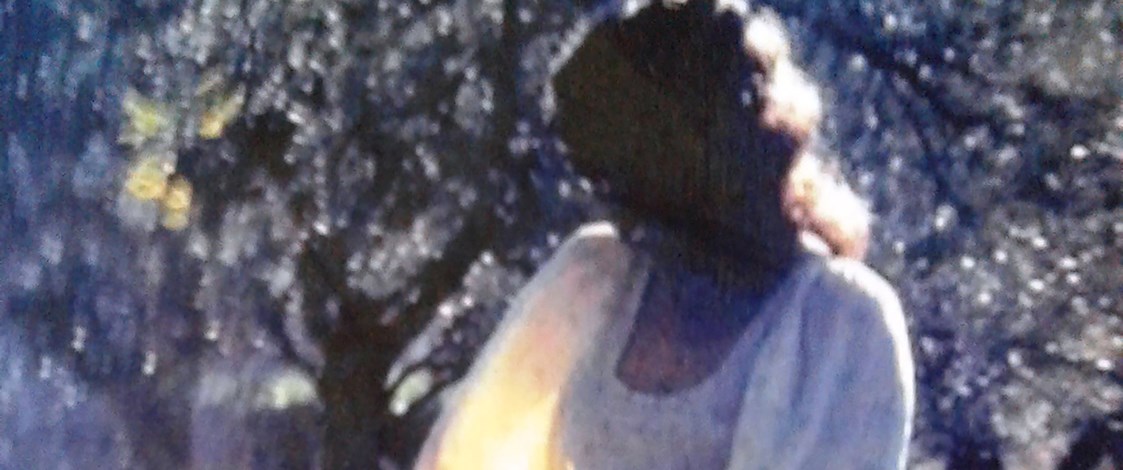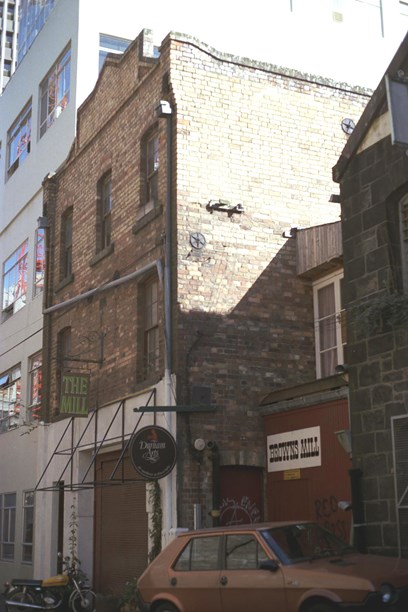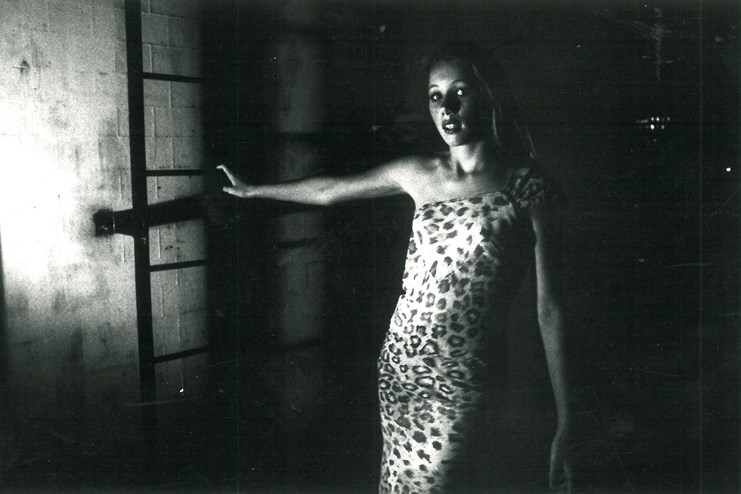Stories
Daphne Mitten
1949-

Daphne Mitten began her career at a time when fashion met art, when commercially available clothes were viewed by a hip generation as boring, and when she had just dropped out of art school.
Like many of her contemporaries Daphne was eager to be a 'hands on' artist. In the late 1960s she enjoyed the Auckland city mix of traditional haberdashers and counter-culture vibes in places such as Nova boutique, Theatre Lane and Brown’s Mill in Durham Lane, Auckland’s first craft cooperative.
The latter, established in 1968 in a former flourmill, attracted jewellers, leather craftspeople, furniture makers, textile artists and a number of aspiring fashion designers. Brown’s Mill was a major part of "an alternative fashion scene that really nurtured innovative design and led to the establishment of the rash of boutiques established in the 1970s." (Lucy Hammonds in The Dress Circle, 2010).
Daphne herself became a boutique owner at the age of 19. "In the summer of 1968 I discovered this place I’d never seen before. It was called the Winter Workshop, up the stairs above Brown’s Mill in a beautiful old room with wonderful casement windows. There was a pleasant mature lady sewing at a machine and a charismatic blonde, Marie Collins, making fringed leather jackets."

Brown's Mill. Image © Sir George Grey Special Collections, 1052-B9-31A.
It transpired that the Winter Workshop was up for sale for $500, a princely sum and definitely out of Daphne’s reach. Nonetheless, as she made her way home that day, she daydreamed about owning it. Call it serendipity or divine intervention, an envelope in the next day’s mail determined her destiny. "In it was a building society ballot that my deceased father had taken out for me and it was a cheque for $500!"
The deal was sealed complete with the 'mature lady', a Mrs Morris, and the sewing machine. Artist Barry Linton painted an "exquisite sign" and the proud owner of the Rosy Boutique began scouring the labyrinths of Karangahape Road for fabrics and trimmings. Mrs Morris (she was always 'Mrs Morris' to Daphne), who had trained as a seamstress in 1920s London, sewed the ensuing creations.
Rosy was a relatively short-lived venture. A downstairs neighbour, knitwear designer Pierrette Viscoe, invited Daphne to join a design workshop; a collective with Pierrette’s artist/sculptor husband Warren, their friends Claire and Murray 'Griff' Griffin, leather maker Bruni (Brunhilde) Tosswill and children’s clothing designer Colleen Rees.
The Tigermoth collective started life in a basement in Swanson Street. The unflappable Mrs Morris had, without complaint, traded in her airy top floor room for the windowless basement workshop and its artsy occupants. "She was a wonderful woman who was really my backbone in those early days," Daphne recalls. "I’d cut things and she’d say 'I’ve never made anything like that before, but it works and she’d do it."
Despite the generation gap (Mrs Morris would have been in her 60s) theirs was a comfortable working relationship. In a way it mirrored Daphne’s own upbringing. She had learned to sew and crochet alongside her maternal grandmother in Hamilton with whom she’d always lived, her own mother having died giving birth to her. "Grandma let me use the treadle sewing machine to make doll’s clothes. She was happy to let me sew – and sew I did. And of course she sewed a lot of my clothes."
"She also had some beautiful things of my mother’s. I remember a floral crepe dress, a tweed coat and her wedding gown. There was a ravishing deep forest green satin evening gown with self-covered buttons down the back and bolero, both ruche-trimmed. They were all beautifully cut. I think a lot of my work at Tigermoth was influenced by those dresses. I used them to model other garments on. They also helped me to know my mother. I know that she loved beautiful things and that she could actually make beautiful things. And I did have a sense of bringing that through in my later design work. She had fabulous colour sense too. And colour was so important to me, especially when I began textile painting."
Another major boost to Daphne’s fashion career came as a 3rd Form (Year 9) student at Waikato Diocesan School for Girls. 'Clothing' was a compulsory subject, loathed along with the teacher by all of Daphne’s friends. She was the exception. "I liked it and the teacher encouraged me. She taught me how to make patterns, just simple stuff, but that gave me confidence to later make my own designs – that and my grandmother’s 'of course you can do it' attitude." In the Tigermoth heyday nothing seemed impossible. "We did just live for the day," Daphne says.
The New Zealand alternative fashion scene was influenced by what was happening overseas, particularly in swinging London where textile designer Celia Birtwell’s floaty fabrics were paraded by The Beatles, Rolling Stones, Marianne Faithfull, Bianca Jagger and their glamorous contemporaries. Nova, English Vogue and the French Elle magazines were linchpins for young Kiwi designers. "My ideas came from exploring fabric, exploring the bias cut and 'less equals more' construction with subtle detailing," Daphne says. "I hated over-constructed clothes."

A bias cut sheath dress with a zig zag hem. Image © Daphne Mitten.
Favourite haunts for fabric, haberdashery and accessories were old warehouses in Darby Street and Elliot Street, Wah Lee in Hobson Street for Chinese silks, printed silk jersey from a fabric remainder shop run by a colourful woman in K Road, and further up the road the treasure trove that was Rendells basement. "I remember using about seven metres of Rendells sari silk in a dress with ruched bodice and wrists. There were African kangas (sarongs) too and I made those into long wrapped dresses. I can recall a bolt of satin with little bows printed on it. I used that to make retro undergarments and they sold very well. I would take volumes of fine muslin, and dye it and edge it with the bias binding from Rendells. Looking back at those early clothes I think the sari silk dresses stand out for me. They were ethereal."
There was also a leather warehouse opposite the Cook Street Market where she found skins for bespoke leather jeans with eyelet punched decoration/ventilation. From chamois skins she would make svelte skirts and bodice tops, thong-laced to accord with the body shape.
At the end of her first Tigermoth year Daphne went overseas. She recalls her rather startling travel outfit – a maxi coat of fake green crocodile fabric worn over a maxi triangle bra dress consisting of 1950s patterned silk jersey held together with string ties, and natural leather and wood high-stacked sandals. "I was blissfully unaware that I was probably a little bit out there." Actually she would have fitted right in to the London of Biba, bell-bottoms and late hippydom.
Returning to Tigermoth after an 18-month OE, things had inevitably changed. Mrs Morris had retired, replaced by talents such as Jo Rose and Gwyneth Phillips who later co-established the Pussyfooting boutique with Miranda Joel. Membership of the collective had changed too.
But the biggest change came with the fire that destroyed the Swanson Street building in 1974. "Overnight there was no Tigermoth. We eventually re-established ourselves above McKenzie’s in Queen Street in a glorious old art deco building. I think that the initial fire of Tigermoth, dare I say it, had gone out with that fire. In the mid to late seventies there was just a different air about everything."
One major factor was that the Queen Street boutique had no workroom. Daphne and Michael McCarthy, a new talented partner in the collective who was trained as a cutter, moved into a workshop in Victoria Street and then to a peppercorn rental studio in Federal Street, where their neighbours were photographers Gillian Chaplin and Anne Noble, painter Richard McWhannell, and 20th century modern collector Ken Neale (now in Sydney). "That was another environment where other people dropped in. And I remember Michael and I would run down with the clothes on our shoulders to Queen Street."

Behind the scenes at a Tigermoth show. Daphne Mitten (left) and Michael McCarthy (centre). Image © Daphne Mitten.
By 1981 Pierette had found new premises in Parnell, then emerging as a fashionable suburb. For a while there were two shops and the Parnell Tigermoth would continue for another 10 years.
For Daphne, the inner city vibe was what had excited her creatively. She also had new family responsibilities. Her beloved grandmother was in need of care, and Daphne herself was soon to give birth to the first of her two daughters. "My demise from Tigermoth was more of a quiet removal I guess."
The creative urge however, has never lessened. From her Grey Lynn home studio Daphne started painting directly on to fabrics. "They were fast and fun and terribly 80s," she laughs. Persuaded by artist friends to learn to screen print, she developed an unusual technique of outlining images in gunmetal or black on fabric and colouring them in by hand.

Daphne Mitten's hand painted fabrics, 1980s. Image © Daphne Mitten.
In the mid-1980s she had her own shop, 'Daphne Mitten' in West Lynn. As well as clothing, some of which she sold through Street Life, she was producing what she describes as 'atmospheric' interior fabrics. These richly-coloured one-off printed pieces inspired by her love of the natural environment would become bedspreads, curtains, cushions, banners and hangings. "Humble calico is transformed in Mitten’s hands into something exotic and rich," wrote Metro journalist Nicola Legat in November 1988.
There was also a line of Esther Williams-style swimsuits which were great sellers. A re-run ended in tears though, as someone ran off with the samples.
While she enjoyed this new phase of her creative life, in the late 1980s making a living was much more difficult than it had been the easy-flowing money years of the 1970s. With the stock market crash, retail had practically frozen.
Gardening had always been an interest for Daphne; another legacy from her grandmother. In her late 40s, Daphne returned to study, enrolling in the Landscape Design course at Unitec.
She is now an award-winning landscape architect and garden designer with a busy practice on Waiheke Island where she has lived for the past 25 years. "It does all seam together pretty well.When I worked on fabrics you’d quite often see a kind of landscape or plant reference there. I’ve always loved making old things in new ways and I’ve always liked drawing and observing."
There are still times, she admits, when she would like to be making clothes. "I’ve still got that creativity for fabrics in me but I actually think that life was about expressing being young and full of a particular energy. I see younger designers expressing that now and I love it."
Text by Katherine Findlay. Banner image © Daphne Mitten.
Last published December 2016.